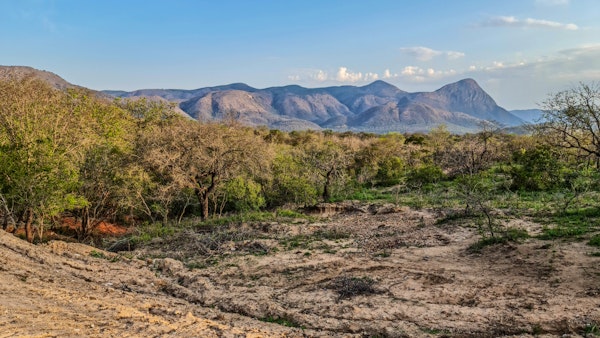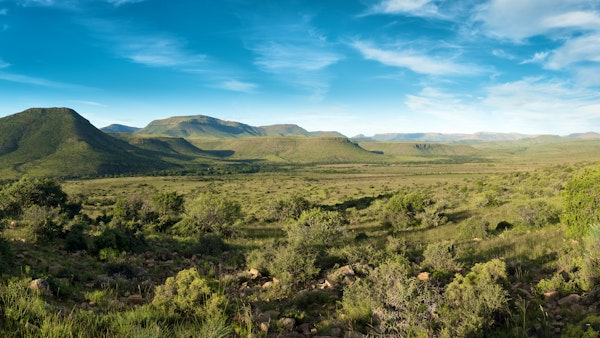South Africa
Description
South Africa's largest city, and the nations economic engine, is Johannesburg, which is often mistaken as the country's capital city. The label of “capital city" is, in fact, split between Cape Town, the legislative capital, Pretoria, the administrative capital, and Bloemfontein, the judicial capital. It is, however, too easy to exclusively define the South African experience by these metropoles, when this diverse nation is home to nearly 50 million people who are spread throughout South Africa's nine provinces: the Western Cape, Eastern Cape, KwaZulu-Natal, Free State, North-West Province, Northern Cape, Mpumalanga, Limpopo and Gauteng.
The climate zones of South Africa vary from desert in the southern Namib (in the northwestern corner of the country) to the lush subtropical climate along the Mozambican border and the east-coast. From east to west, the land quickly rises over a mountainous escarpment towards the interior plateau known as the Highveld. Even though South Africa is classified as semi-arid, there is considerable variation in climate as well as topography, with 2,798 km of coast-line and the Drakensberg mountains rising to an impressive 3,410m.
South Africa is considered a global leader in nature conservation. It is know for its numerous reserves and, particularly, the large mammals that are found in the north-east of the country. The Kruger National Park, Waterberg biosphere and surrounding regions allow many African animals to thrive, including lions, leopards, white rhinos, blue wildebeest, kudus, impalas, hyenas, hippopotamus and giraffes. This is certainly Africa's most convenient location for tourists out to spot the Big Five.
The most prevalent biome in South Africa is grassland (particularly on the Highveld) but the vegetation here is difficult to pin-down as South Africa is the 6th most bio-diverse country in the world. With more that 20,000 different plants (which equates to 10% of all plant species found globally) South Africa has the grasses, low shrubs and various thorn-trees often associated with a typical view of Africa, but there are also a wide variety of succulents and aloes in the dryer Karoo and Namaqualand regions, and some surviving indigenous coastal forrest along the east coast. A section of the Western Cape is home to a unique floral kingdom (one of only six in the world) know as the Fynbos Biome(literally 'Fine Bush'). This endemic floral kingdom makes the Cape one of the most bio-diverse regions in the world, supporting over 9000 endemic floral species.
South Africa was once also the infamous home of 'apartheid' – a formalised form of racial segregation that saw South Africa's largely black population oppressed by the white minority. The policy was legislated in 1948 by the National Party to ensure that the whites in South Africa could maintain the highest standard of living anywhere in Africa, at the expense of the local 'non-white' inhabitants, as they were called. In more modern times, Apartheid gave rise to national and international disagreement – South Africa saw increasingly violent protests, anti-apartheid movements such as the African National Congress gained momentum, and the International community sanctioned the country.
By 1990 the National Party government lifted the ban on the African National Congress and other similar parties, and historically released Nelson Mandela after twenty-seven years of incarceration for 'sabotage'. Apartheid was lifted and the 'New South Africa†was born. South Africa's first democratic elections were held in 1994, where the ANC, with Nelson Mandela at the helm, won a landslide victory.
The peaceful transition of power was a triumph of peace and today South Africans are tolerant of the population's wide variety of origins, cultures, and religions. This inclusive attitude is demonstrated by the fact that South Africa has 11 official languages: Afrikaans, English, Sepedi, Sesotho, Setswana, siSwati, Tshivenda, Xitsonga, sisNdebele, isiXhosa and isiZulu. South Africa also recognizes eight “unofficial languagesâ€: Fanagalo, Khoe, Lobedu, Nama, Northern Ndebele, Phuthi, San and South African Sight Language
Currently, the main sports in South Africa are soccer, rugby, cricket and boxing, but the main focus is on soccer as South Africa is hosting the 2010 FIFA Soccer World Cup in mid-2010. lawn bowls, swimming, golf, basketball and netball also draw significant followings, while surfing growing quickly, especially in Durban.


